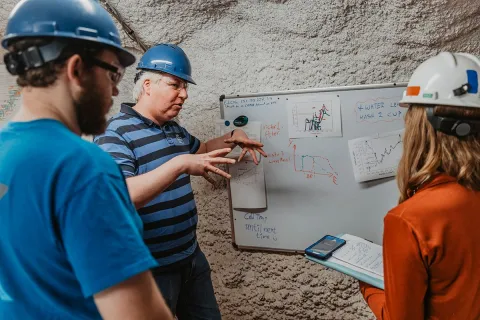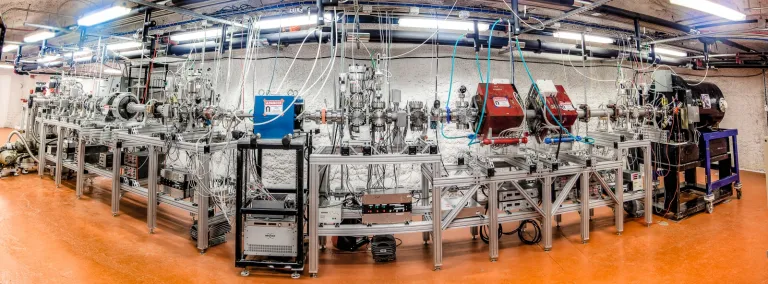CASPAR informs some James Webb Space Telescope discoveries
CASPAR is helping scientists understand the evolution of the first stars and the early universe.
For physicist Mark Hanhardt, the stunning photos of the early universe being returned to Earth by NASA’s James Webb Space Telescope (JWST) are a bit like turning a cell phone camera on ourselves.
“Those images of the early galaxies and stars are like 13-billion-year-old selfies,” said Hanhardt. “Those images are us, in a very primordial form.”
Stars are sometimes called the “cauldrons of the cosmos” because their internal processes break and forge pieces of atoms together to make new elements. The Big Bang kicked off the universe with two primary elements, hydrogen and helium, but it’s the mechanism inside stars that churned out most of the rest of the matter we see around us today. That means ancient stars forged the atoms that make up everything we know, from rocky planets to asteroids to kangaroos to human beings.
Part of the mission of the James Webb Space Telescope is to help us understand how the universe evolved over time. The JWST has found some of the earliest stars and galaxies in our universe, formed less than 400-million years after the Big Bang. Astronomers can use the ancient light spectrum gathered by Webb to determine the predominant elements contained inside those early stars and galaxies. These light signatures, that show the elemental makeup of different stellar objects over time, can help us understand the evolutionary path of the universe.
Despite its incredible power, JWST cannot peer inside a star itself. It can’t see the internal mechanisms that break apart atoms like hydrogen and helium and smash their protons and neutrons together into more complex elements.
“The atoms that make up you and me were forged inside the heart of the stars. And we're studying how that happens. CASPAR is helping JWST tell the story of how we got from there to here.”
This is where CASPAR comes in. The Compact Accelerator System for Performing Astrophysical Research, (CASPAR) is housed at the Sanford Underground Research Facility (SURF) in South Dakota. CASPAR can recreate the conditions inside stars, including the first stars in the universe, that were very different than most stars today.
“With CASPAR, physicists are literally tracing our chemical lineage,” Hanhardt said. “The atoms that make up you and me were forged inside the heart of the stars. And we're studying how that happens. CASPAR is helping JWST tell the story of how we got from there to here.”
The recipe those early stars used to create more complex elements is still not fully understood. By recreating the environment inside these stars, CASPAR can allow physicists to piece together how they evolved.
Dr. Frank Strieder is a physics professor at South Dakota Mines and one of the principal investigators who lead CASPAR. Strieder says the challenge for physicists is deciphering the series of subatomic level reactions that are part of a complex process called stellar nucleosynthesis that occur in different types of stars.
Early massive stars were comprised of only two elements, hydrogen and helium. They had different reaction processes than stars today. When those shorter-lived early universe stars exploded, they spread the new elements they forged into the interstellar medium, to be taken up and forged again by future generations of stars.
“Stars of significantly greater mass than our Sun usually serve as the cosmic cauldrons, actively ‘polluting’ the universe with heavier elements,” Strieder said.
Today, modern massive stars have different processes of nucleosynthesis, because they have access to a range of elements left behind by stars before them. Cosmic events like supernova and neutron star mergers can create elements with another set of processes. The physicists running CASPAR, are trying to decipher it all.
“As soon as you understand the full reaction chains that happen inside the stars, and have all the parameters, you can exactly predict how the star evolves and how long it lives,” Strieder said.

tars forge new atoms like building blocks—one on top of the other. However, there are gaps in the element building process of the early universe that we don’t yet understand. One of them is how the jump was made from helium to lithium and lithium to beryllium inside the Big Bang and those first-generation stars. Lithium is third on the periodic table, and the third element to be created in the universe. In the most basic sense, lithium was created during atomic reactions inside stars that pasted an extra proton and neutron to a helium atom—bumping up the atomic number from two (helium) to three (lithium).
But there is a problem. Lithium is highly unstable until both a proton and an additional neutron are added to balance it out. Lithium with just one additional proton, called lithium-5, has an incredibly short half-life of around 10-20 seconds—this means it would never be stable long enough to be a building block for the next atom. It’s sort of like a broken bridge that can’t be crossed.
“This is a prominent gap,” Strieder said. “It’s because there are no mass five stable nuclei.” He said the same bridge is broken again when trying to go from lithium to the next element in the chain, because lithium-8 is also too unstable to be a building block for beryllium. “So, you can produce a small amount of lithium 6 and lithium 7, but to go higher is a challenge."
These gaps contribute to the cosmological lithium problem, a fundamental difference between the theoretically expected and the observed amount of lithium in early stars. “A comprehensive answer to this discrepancy remains elusive to date,” he added.
Helping fill in the gaps of early stellar nucleosynthesis is a plan for future research with CASPAR at SURF. It’s an exciting time for physicists, like Strieder and Hanhardt, to explore the evolution of the cosmos, with tools on hand like JWST and CASPAR.
“CASPAR appeals to me, specifically because of the poetry of it,” Hanhardt said.
Hanhardt is starting his doctoral thesis on the findings of CASPAR with a poem, by Alfred Tennyson called Flower in the Crannied Wall.
The poem connects the complexity of a simple flower to the complexity of the universe. This is what physicists are trying to do with CASPAR.
“The idea that understanding these tiny reactions on the smallest quantum scale gives us the ability to understand the universe on the grandest scale possible is amazing. It helps us recognize and appreciate how profound the images coming back from JWST really are,” Hanhardt said.
